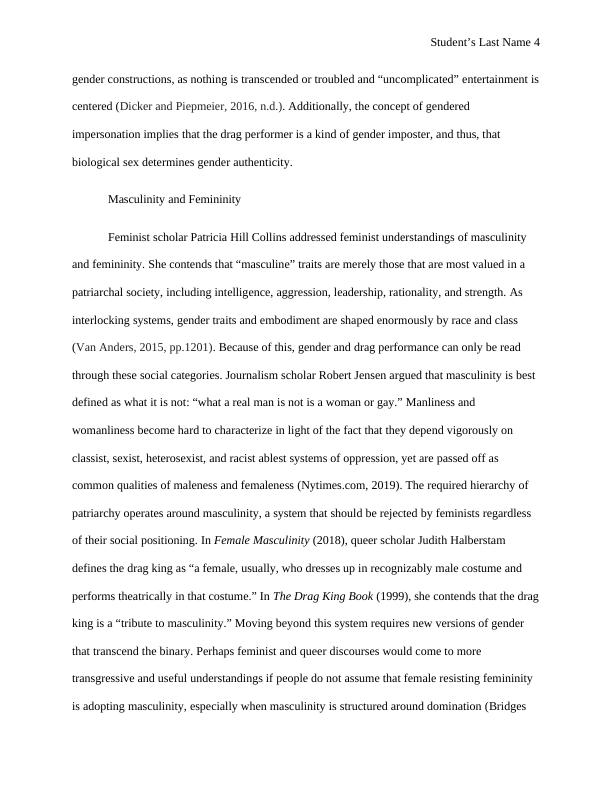Gender, Culture, and Identity
Added on 2023-02-01
15 Pages4349 Words39 Views
Student’s Last Name 1
Gender, Culture, and Identity
By (Name)
Course
Professor
University
Date
Gender, Culture, and Identity
By (Name)
Course
Professor
University
Date

Student’s Last Name 2
Introduction
The drag performance, - the parody of gender via cross-dressing and adoption of
mannerism- has been in existence and still continues to be part of the United States LGBTQ
communities. The performance is a representation of a political as well as social critique of
gender norms. Since heterosexual norms hugely dictate gender roles, the drag performance
subverts the socially-constructed links that exist between sex, gender, and sexuality which
personify heteronormatively. However, the LGBTQ community is normally involved during
drag performances. Drag functions among LGBTQ communities in gay cultural spaces, and also
to heteronormative women in U.S. popular culture. Exploring drag across various social
locations and cultural sites illuminate how it is reflective of social privileges and oppression.
Straight women and men often perform drag in ways that highlight their interactions with sex,
gender, and power. Additionally, drag often crosses over into heteronormative popular culture.
Beyond traversing various cultural spaces, it has also moved from the physical stage to cyber
platforms catalyzed by new, digital and internet technologies. Exploring the drag performance
provides further insight on cultural understandings of sex, gender, sexuality, and embodiment
that regulate social power and shape lived experiences.
A historical framework shows drag is temporally situated within cultural attitudes
regarding sex and gender. Most often, theories of drag are ahistorical and anachronistic as older
theories of drag are used to frame new drag performances in ways that may not consider the
performers’ temporal material realities. Despite that drag is performance art, it is also considered
political and during other times, it is merely viewed as entertainment. It can often reify
normative thinking, while in other deployments it transgresses those limits. The performer and
the location of the performance shapes the constitutions and effects of drag performance.
Introduction
The drag performance, - the parody of gender via cross-dressing and adoption of
mannerism- has been in existence and still continues to be part of the United States LGBTQ
communities. The performance is a representation of a political as well as social critique of
gender norms. Since heterosexual norms hugely dictate gender roles, the drag performance
subverts the socially-constructed links that exist between sex, gender, and sexuality which
personify heteronormatively. However, the LGBTQ community is normally involved during
drag performances. Drag functions among LGBTQ communities in gay cultural spaces, and also
to heteronormative women in U.S. popular culture. Exploring drag across various social
locations and cultural sites illuminate how it is reflective of social privileges and oppression.
Straight women and men often perform drag in ways that highlight their interactions with sex,
gender, and power. Additionally, drag often crosses over into heteronormative popular culture.
Beyond traversing various cultural spaces, it has also moved from the physical stage to cyber
platforms catalyzed by new, digital and internet technologies. Exploring the drag performance
provides further insight on cultural understandings of sex, gender, sexuality, and embodiment
that regulate social power and shape lived experiences.
A historical framework shows drag is temporally situated within cultural attitudes
regarding sex and gender. Most often, theories of drag are ahistorical and anachronistic as older
theories of drag are used to frame new drag performances in ways that may not consider the
performers’ temporal material realities. Despite that drag is performance art, it is also considered
political and during other times, it is merely viewed as entertainment. It can often reify
normative thinking, while in other deployments it transgresses those limits. The performer and
the location of the performance shapes the constitutions and effects of drag performance.

Student’s Last Name 3
Because of this, people should move beyond discussing performances that utilize drag in a
monolithic sense and conceptualize them as genres of drag. Motivations to do drag are directly
connected to personal experiences, material realities, and social positioning. When people
perform drag, they bring themselves to the performances because the medium of drag is the
body. It is a layered performance of transformation that moves between and among various
personas and egos. In relation to drag queens, the paper discusses what it means to perform
femininity.
Defining Drag
Drag challenges the accepted connection between sex and sexual orientation, where
gender is dependent upon sex. At the most essential dimension, it is the epitome and execution of
sex-related to cross-dressing and reception of idiosyncrasies. Briefly, drag results in appearance,
cross-gendered conduct, and mentality by rebelliousness with regularizing sexual orientation
jobs as dependent upon social contents administered by organic sex (Keener, 2015, pp.486).
Despite this shared basis, the effect, composition, and motivations of drag performance are far
from universal. Drag discourse needs to be updated as a result of changing technologies and
cultural understandings of gender, sexuality, and power (Baker, Burton and Smith, 1994, n.d.). It
is important to note the existence of drag within entertainment performance. Performance art
scholar Michael Moore tracks the history of cross-dressing used on stage and screen, yet fails to
acknowledge the vast differences between drag, cross-dressing, and impersonation (Moore,
2013, pp.17). He suggests, “Drag, the wearing of clothes of the opposite sex, is as old as gender
itself.” Because it is socially-situated and adaptive to specific social climates, its value
transcends entertainment. Moore's understanding of drag is depoliticized and sanitized without
considering gender politics. In these instances, drag merely upholds dominant models of sex and
Because of this, people should move beyond discussing performances that utilize drag in a
monolithic sense and conceptualize them as genres of drag. Motivations to do drag are directly
connected to personal experiences, material realities, and social positioning. When people
perform drag, they bring themselves to the performances because the medium of drag is the
body. It is a layered performance of transformation that moves between and among various
personas and egos. In relation to drag queens, the paper discusses what it means to perform
femininity.
Defining Drag
Drag challenges the accepted connection between sex and sexual orientation, where
gender is dependent upon sex. At the most essential dimension, it is the epitome and execution of
sex-related to cross-dressing and reception of idiosyncrasies. Briefly, drag results in appearance,
cross-gendered conduct, and mentality by rebelliousness with regularizing sexual orientation
jobs as dependent upon social contents administered by organic sex (Keener, 2015, pp.486).
Despite this shared basis, the effect, composition, and motivations of drag performance are far
from universal. Drag discourse needs to be updated as a result of changing technologies and
cultural understandings of gender, sexuality, and power (Baker, Burton and Smith, 1994, n.d.). It
is important to note the existence of drag within entertainment performance. Performance art
scholar Michael Moore tracks the history of cross-dressing used on stage and screen, yet fails to
acknowledge the vast differences between drag, cross-dressing, and impersonation (Moore,
2013, pp.17). He suggests, “Drag, the wearing of clothes of the opposite sex, is as old as gender
itself.” Because it is socially-situated and adaptive to specific social climates, its value
transcends entertainment. Moore's understanding of drag is depoliticized and sanitized without
considering gender politics. In these instances, drag merely upholds dominant models of sex and

Student’s Last Name 4
gender constructions, as nothing is transcended or troubled and “uncomplicated” entertainment is
centered (Dicker and Piepmeier, 2016, n.d.). Additionally, the concept of gendered
impersonation implies that the drag performer is a kind of gender imposter, and thus, that
biological sex determines gender authenticity.
Masculinity and Femininity
Feminist scholar Patricia Hill Collins addressed feminist understandings of masculinity
and femininity. She contends that “masculine” traits are merely those that are most valued in a
patriarchal society, including intelligence, aggression, leadership, rationality, and strength. As
interlocking systems, gender traits and embodiment are shaped enormously by race and class
(Van Anders, 2015, pp.1201). Because of this, gender and drag performance can only be read
through these social categories. Journalism scholar Robert Jensen argued that masculinity is best
defined as what it is not: “what a real man is not is a woman or gay.” Manliness and
womanliness become hard to characterize in light of the fact that they depend vigorously on
classist, sexist, heterosexist, and racist ablest systems of oppression, yet are passed off as
common qualities of maleness and femaleness (Nytimes.com, 2019). The required hierarchy of
patriarchy operates around masculinity, a system that should be rejected by feminists regardless
of their social positioning. In Female Masculinity (2018), queer scholar Judith Halberstam
defines the drag king as “a female, usually, who dresses up in recognizably male costume and
performs theatrically in that costume.” In The Drag King Book (1999), she contends that the drag
king is a “tribute to masculinity.” Moving beyond this system requires new versions of gender
that transcend the binary. Perhaps feminist and queer discourses would come to more
transgressive and useful understandings if people do not assume that female resisting femininity
is adopting masculinity, especially when masculinity is structured around domination (Bridges
gender constructions, as nothing is transcended or troubled and “uncomplicated” entertainment is
centered (Dicker and Piepmeier, 2016, n.d.). Additionally, the concept of gendered
impersonation implies that the drag performer is a kind of gender imposter, and thus, that
biological sex determines gender authenticity.
Masculinity and Femininity
Feminist scholar Patricia Hill Collins addressed feminist understandings of masculinity
and femininity. She contends that “masculine” traits are merely those that are most valued in a
patriarchal society, including intelligence, aggression, leadership, rationality, and strength. As
interlocking systems, gender traits and embodiment are shaped enormously by race and class
(Van Anders, 2015, pp.1201). Because of this, gender and drag performance can only be read
through these social categories. Journalism scholar Robert Jensen argued that masculinity is best
defined as what it is not: “what a real man is not is a woman or gay.” Manliness and
womanliness become hard to characterize in light of the fact that they depend vigorously on
classist, sexist, heterosexist, and racist ablest systems of oppression, yet are passed off as
common qualities of maleness and femaleness (Nytimes.com, 2019). The required hierarchy of
patriarchy operates around masculinity, a system that should be rejected by feminists regardless
of their social positioning. In Female Masculinity (2018), queer scholar Judith Halberstam
defines the drag king as “a female, usually, who dresses up in recognizably male costume and
performs theatrically in that costume.” In The Drag King Book (1999), she contends that the drag
king is a “tribute to masculinity.” Moving beyond this system requires new versions of gender
that transcend the binary. Perhaps feminist and queer discourses would come to more
transgressive and useful understandings if people do not assume that female resisting femininity
is adopting masculinity, especially when masculinity is structured around domination (Bridges

End of preview
Want to access all the pages? Upload your documents or become a member.
Related Documents
Globalization and Its Complication on Gender and Sexualitieslg...
|9
|2360
|454
(solved) Gender and the City PDFlg...
|9
|2235
|279
Intersectionality in Healthcare Assignment 2022lg...
|7
|1772
|17
Not Just a Game: A Critical Exploration of Politics in American Sportslg...
|7
|1936
|282
Social Location: A Self-Reflective Paper on Identity and Cultural Differenceslg...
|10
|3050
|470
